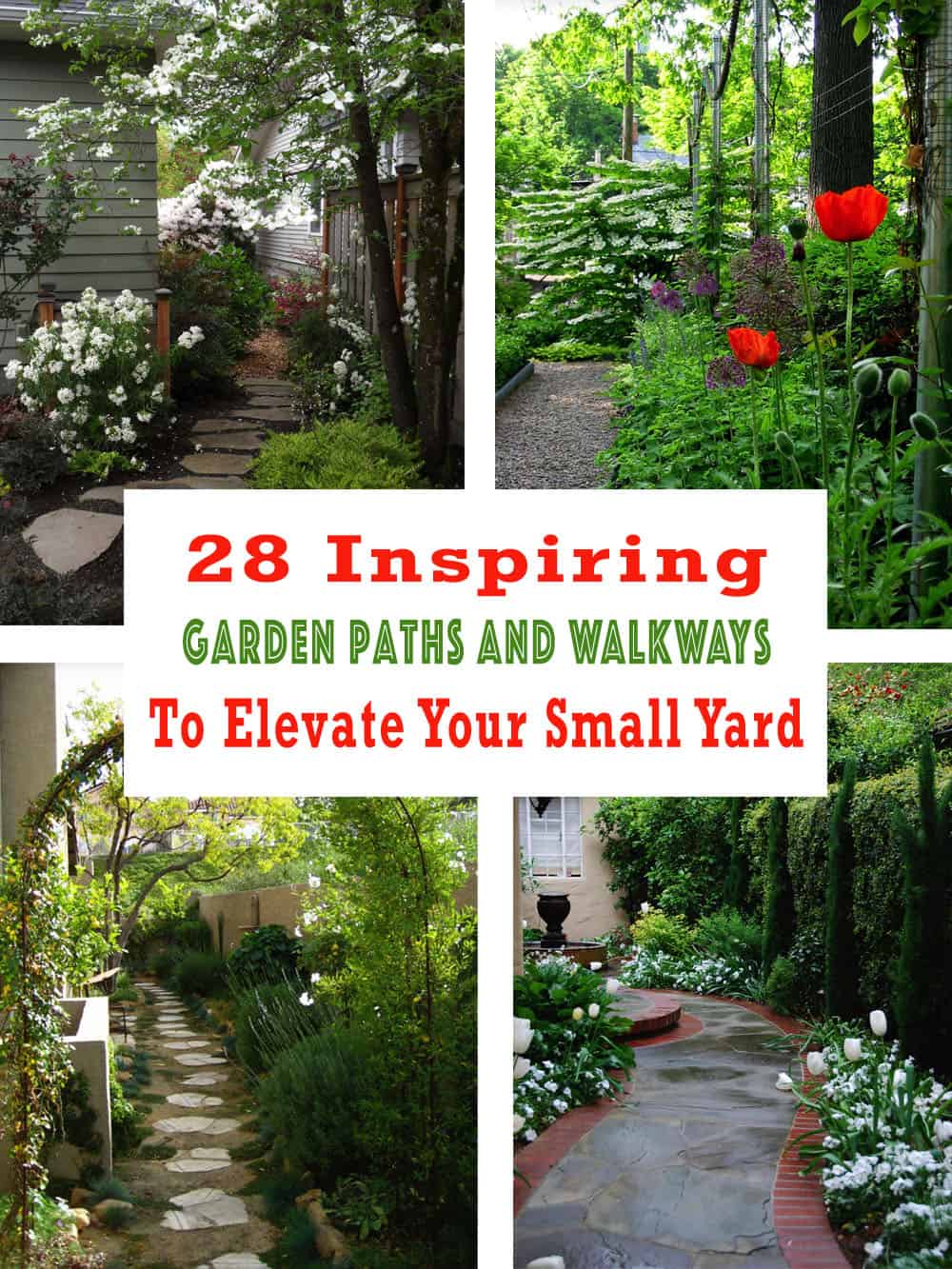
Garden paths can transform your yard into a beautiful and functional oasis, connecting various areas of your property where you can enjoy some fresh air and solace. When planning your garden around your pathways, use this helpful USDA Plant Hardiness Zone Map to determine what zone you live in.
From flagstone pathways meandering through a garden or curving through a narrow side yard, to concrete pavers that lead to a water feature, we have a variety of garden path ideas to help get you started. Check out our collection of creative pathway and walkway ideas that you can adapt to your small yard. Be sure to continue to the end, as we have some very helpful garden tips!
Why Garden Paths Matter in Small Yards
- Create a visual flow that makes a small yard feel bigger
- Direct foot traffic away from fragile plants
- Break up space into garden rooms or zones
- Add texture and structure with different materials
- Bring aesthetic charm and character to any landscape style
Tell Us: Which one of these garden path and walkway ideas do you find most inspiring? Let us know in the Comments below!
1. Front Walk and Garden.
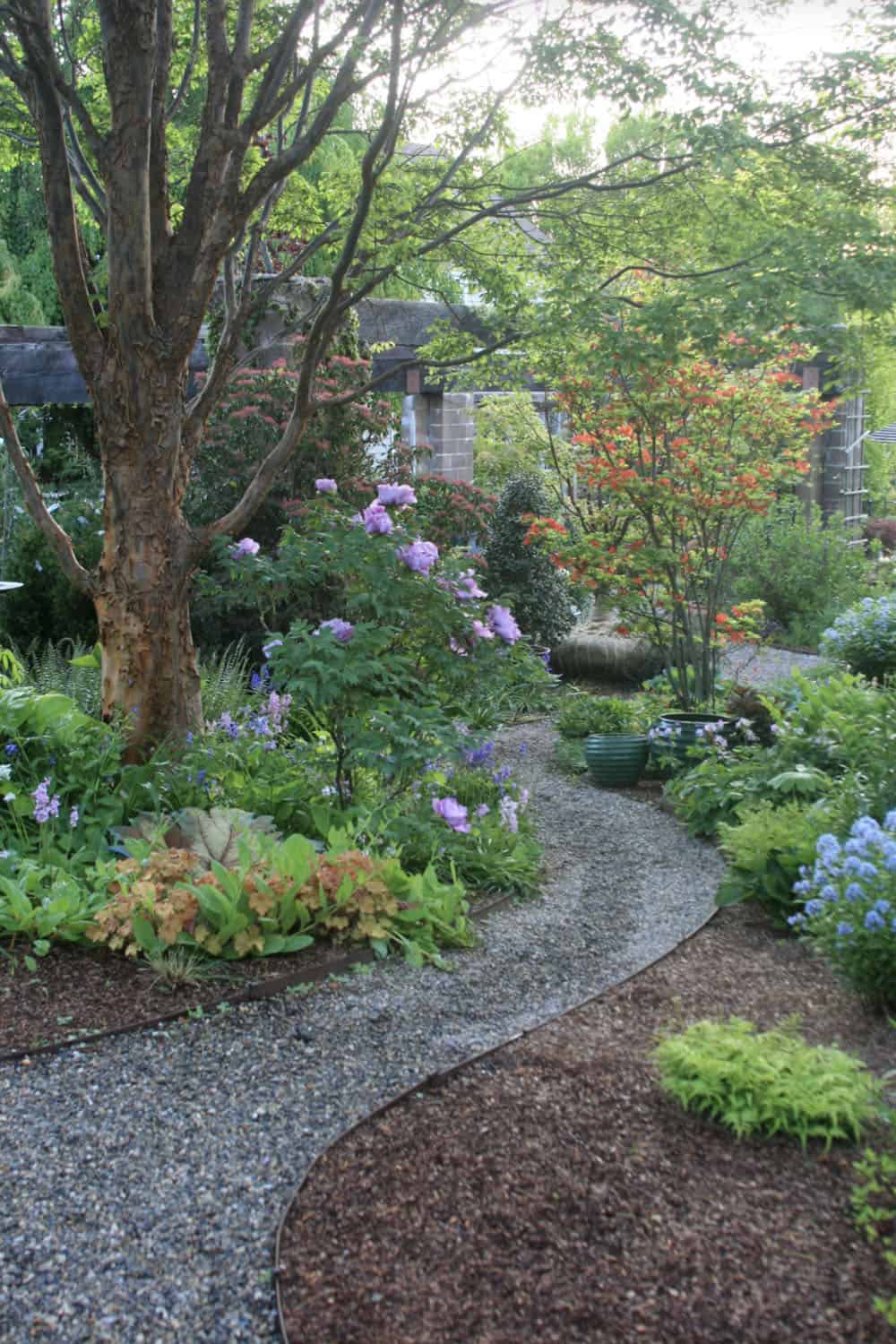
The path is edged with steel edging and then covered with gravel. It keeps the gravel from contaminating the mulched planting beds and vice versa. The plant with the orange blooms at the far end of the gravel path on the right side is an Azalea ‘Gibraltar’, a show stopper! It is hardy to zone 5. The tree is the Paperbark Maple (Acer Griseum). The plant with the lilac colored flowers is a Peonie suffruticosa Kamata-nishiki. It produces huge fragrant flowers in the spring, and will take part shade or full sun. Mature plants are 4-5 feet tall and 3-5 feet wide. Note: This is a tree peonie, it is woody and does not die back in the winter. (via Oliver Nurseries)
2. Red Brick Pathway.
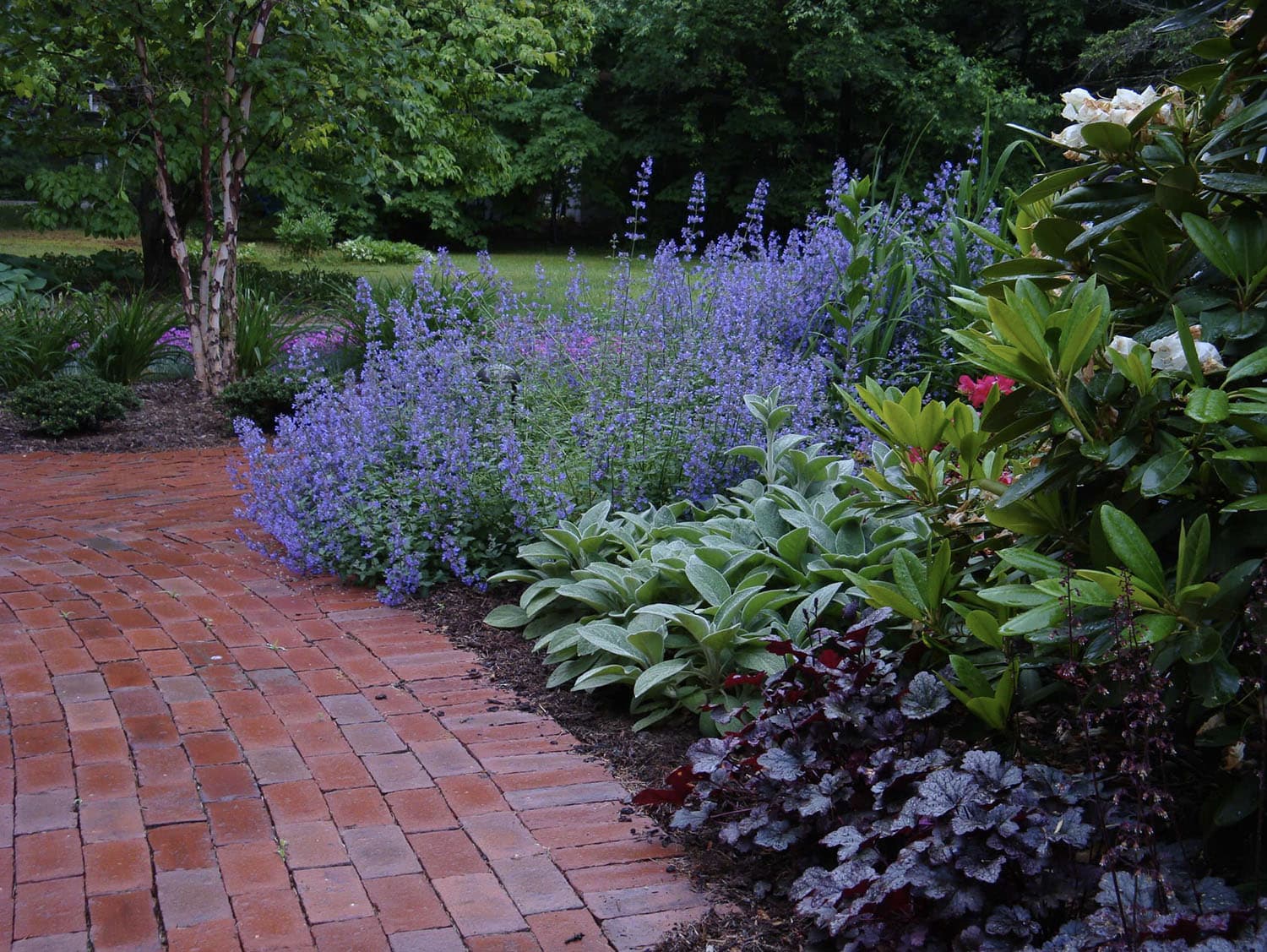
Red brick pavers create an attractive aesthetic in this lush garden, including Bellflowers, Rhododendrons, and a Birch Tree in the background. Add mulch around the plantings to keep the weeds at bay and the soil moist, enhancing the appearance of your garden. (via Blue Heron Landscape Design)
3. Woodland Retreat.
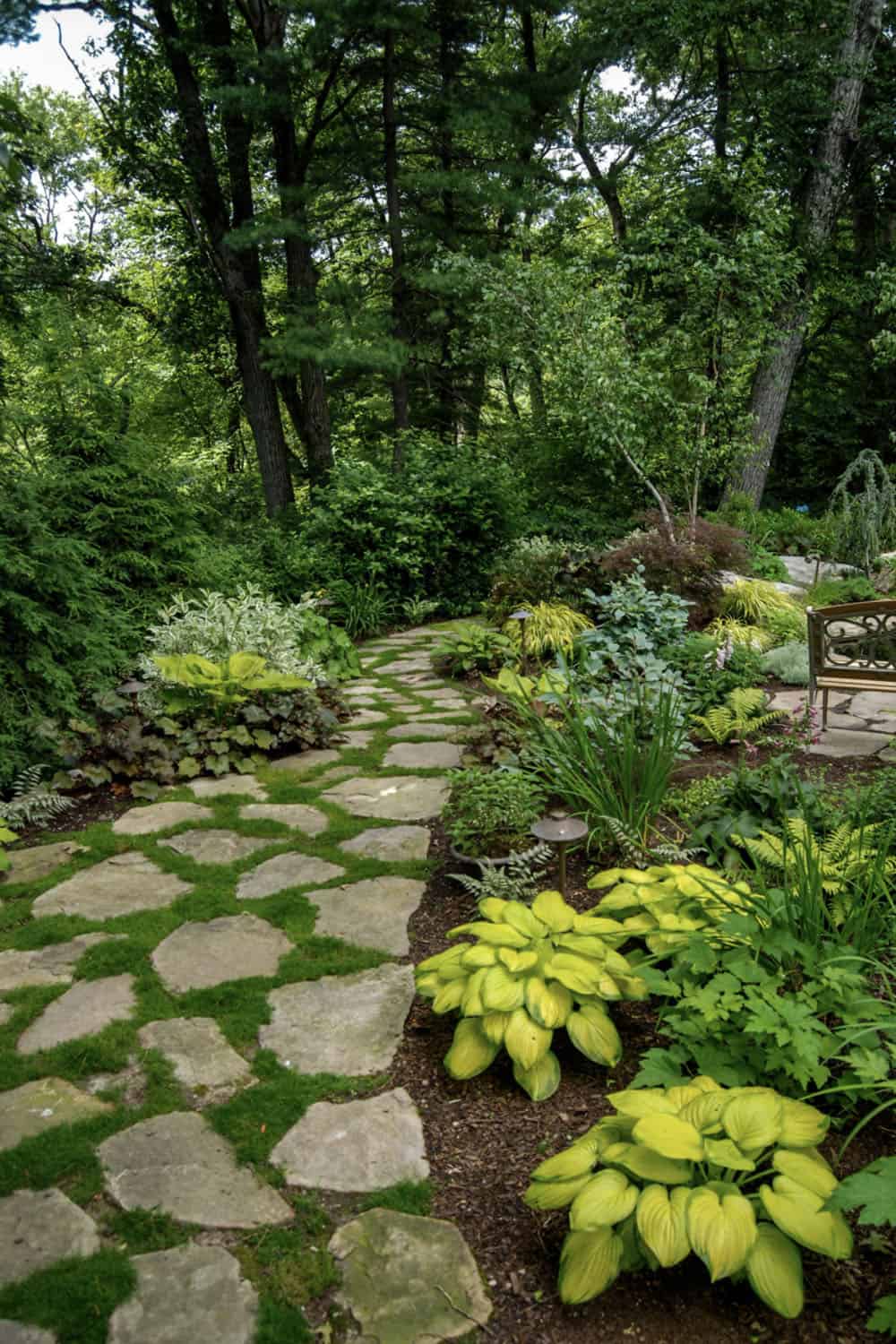
Irregular bluestone stepper path and woodland shade garden. The perennial groundcover between the stepping stones is Sagina subulata (Irish Moss). Irish Moss will grow almost anywhere. It does a good job of spreading to cover any available soil, keeping the area from getting muddy. However, it does need fairly regular water to stay green. It is hardy from zone 4b to zone 9. It likes well-drained soil and should have partial shade in warmer climates.
In the right foreground are Hosta ‘Gold Standard’ (large yellow leaves with green edges). The sharper leaves in the bottom right corner are Anemone. The silvery fern is Athyrium niponicum ‘Pictum’ (Japanese Painted Fern). The shrub with white leaves in the middle left is Cornus ‘Ivory Halo’ (Red Twig Dogwood). Across the path to the right, with the silvery blue-green leaves, is Fothergilla ‘Blue Shadow’. On either side of the shrubs, the grass with the yellow blades is Hakonechloa ‘Aureola’. Behind that, with the maroon leaves, is a Crimson Queen Japanese Maple.
TIP: For a stepper path like this, prepare a compacted sub base and an inch or so of stone dust directly below the steppers. The stones are much less likely to move around if they have a properly prepared base. The base material is a mix of different sizes of crushed stone and stone dust, which compacts well but still allows water to percolate. (via a Blade of Grass)
4. A Peaceful Garden Walkway.
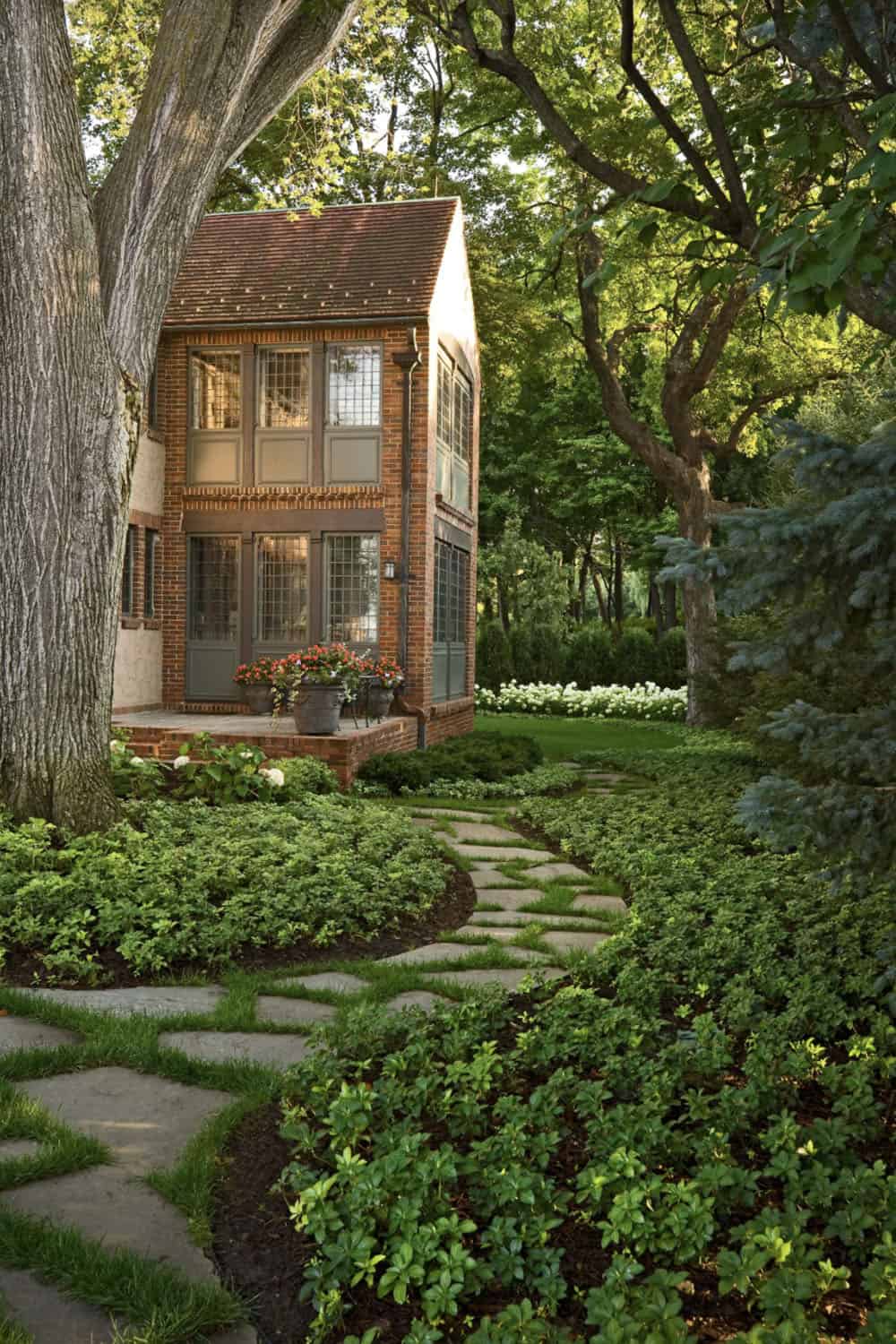
A Lake Minnetonka home features this beautifully landscaped yard with masses of annual flowers that frame Bluestone irregular flagstone steps. In the industry, the term “steppers” refers to stone pieces 8″ to 18″ in diameter, while “flagstone” refers to stone pieces 18″ to 40″ in diameter. Since this path contains some larger pieces, it is flagstone. Also, there is a difference between “irregular” and “patterned.” Irregular is like this in the photo, while patterned refers to stone pieces that have been cut to nominal dimensions and set in various brick patterns (i.e., 12″x12″, 12″x24″, etc.)
The perennial groundcover is called Pachysandra (pack-uh-sandra) or, more specifically, Pachysandra terminalis ‘Green Carpet’. Space your Pachysandra plants anywhere from 6″ to 12″ apart. The spacing comes down to soil, food, mulch, and water. Use good organic, well-drained topsoil, add some aged compost, pine fines, a slow-release acidic fertilizer, and mulch with a finely ground aged mulch (dark brown shredded wood mulch). Water regularly and stay on top of the weeding, and a bed planted 6″ to 8″ on center can fill in by the following season, two at the most. The white flowers in the back are Annabelle Hydrangea (Hydrangea arborescens ‘Annabelle’). (via Windsor Companies)
5. Brick And Blue Stone Pavers.
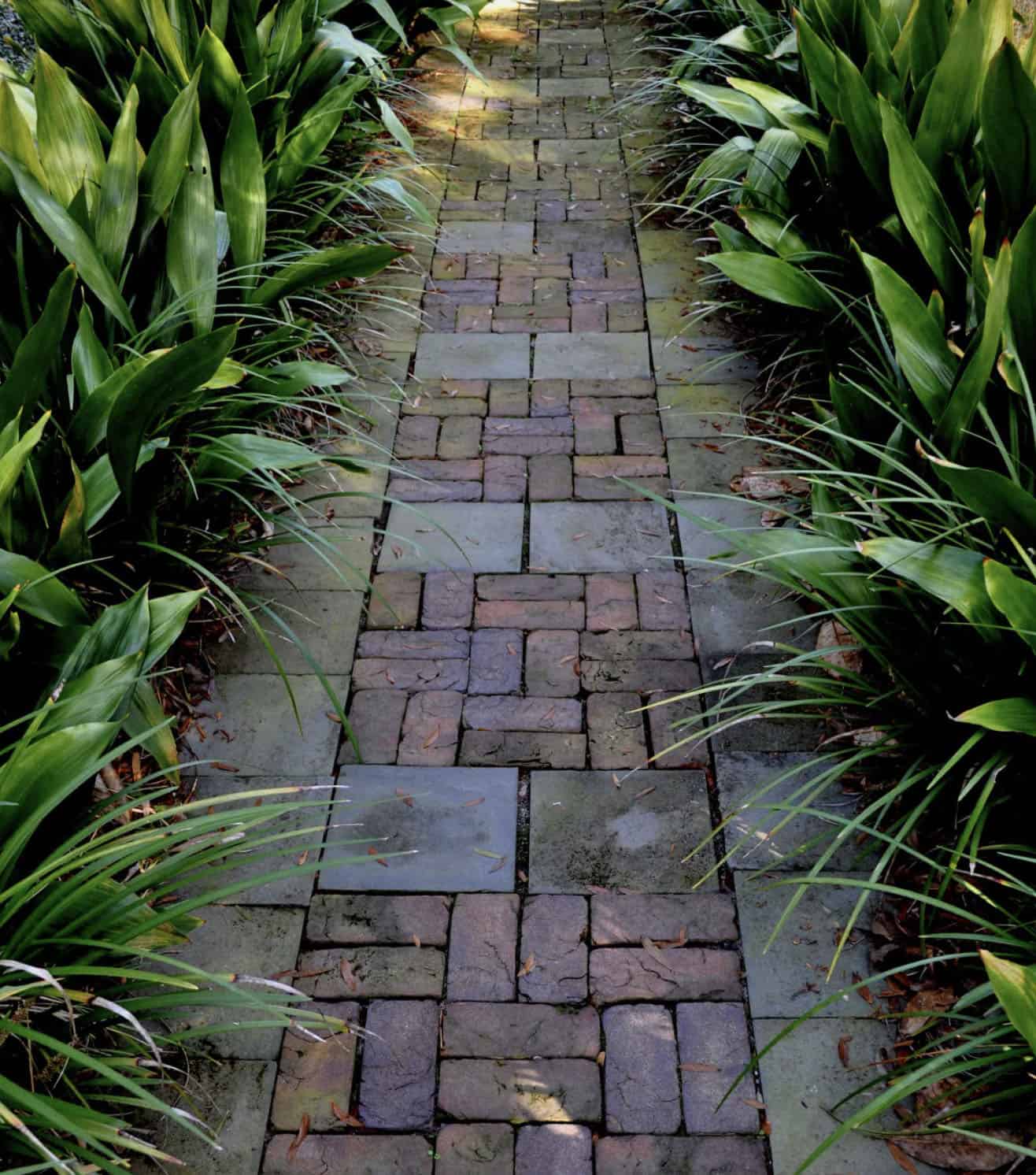
The garden path is Old Carolina Brick Co.’s Savannah Grey bricks with bluestone pavers, sourced from Savannah Hardscapes. The plants bordering the walkway are Cast Iron Plant (larger plants), and the smaller fine foliage looks like liriope. The plants are shade-loving. (via Frederick + Frederick Architects)
6. Curvaceous Pea Gravel Path.
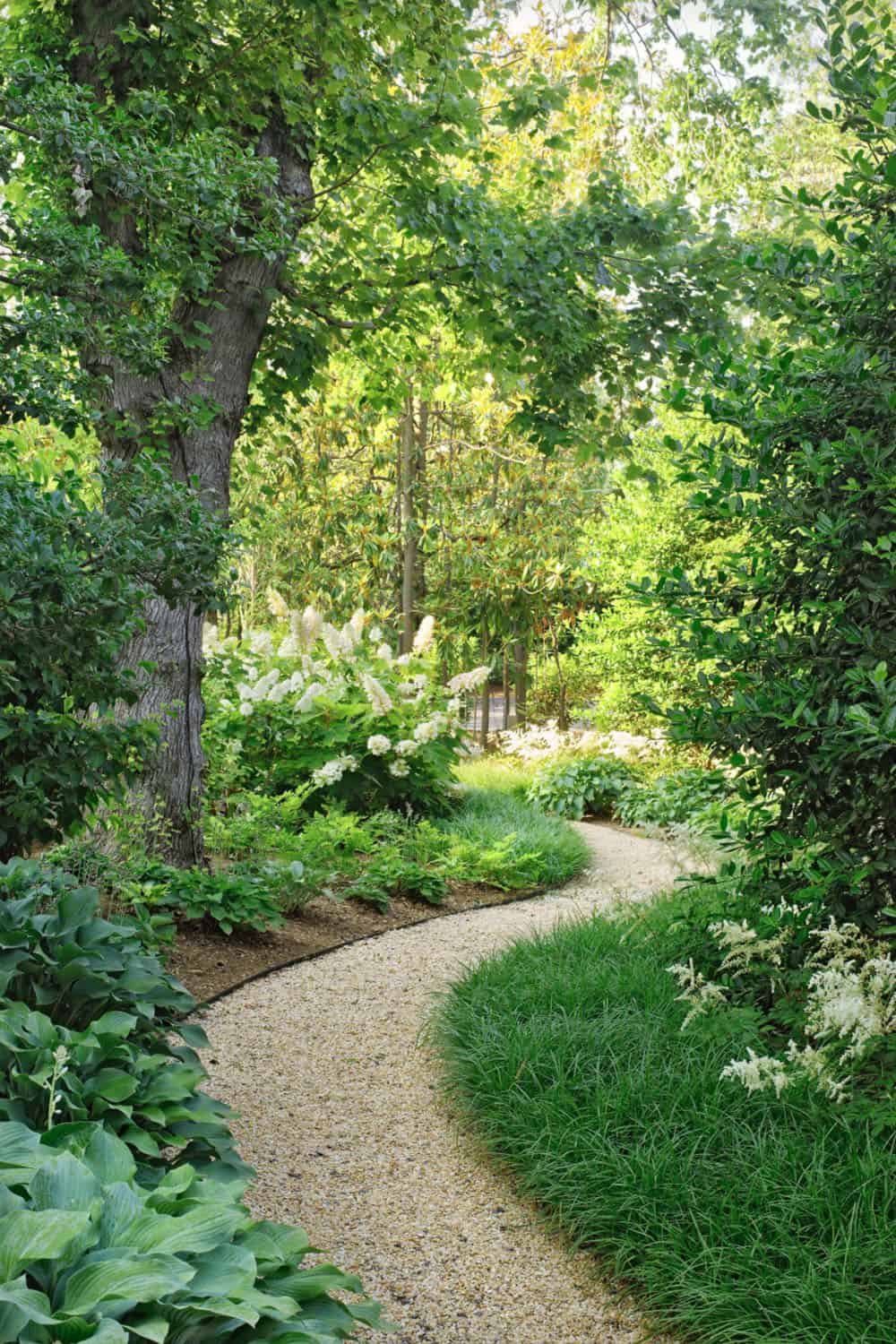
A curvaceous pea gravel path directs the visitor through the woodland garden located at the back side of the house. Pea gravel is sandy in color and can be obtained from any quarry. Pea gravel is set on a compacted sub-base that is tamped. 1-1.5″ of pea gravel is set atop the tamped base. Pea gravel should not feel like you are walking in sand. It is recommended to use a 1/2 ” as a top coat. It’s also good to rake it to keep it neat and contain it with some type of edging; this one is edged with metal edging.
The pathway is planted with drifts of Erie and Chindo Viburnumns, Oak leaf Hyrangeas, Ferns, and Hostas. On the right of the path is a perennial called Astilbe. They like shade and are low maintenance. They just need moisture. To achieve this look it is best to plant the astilbe 18″ -24″ on center. A row of hollies was added to block the view of the son’s home. To the right of the gravel path is Liriope muscari. A ground cover that spreads and fills in very nicely. The liriope grows in zones 4-9 and does well in shade. (via Katia Goffin Gardens)
7. Create A Pathway Over A Dry River Bed.
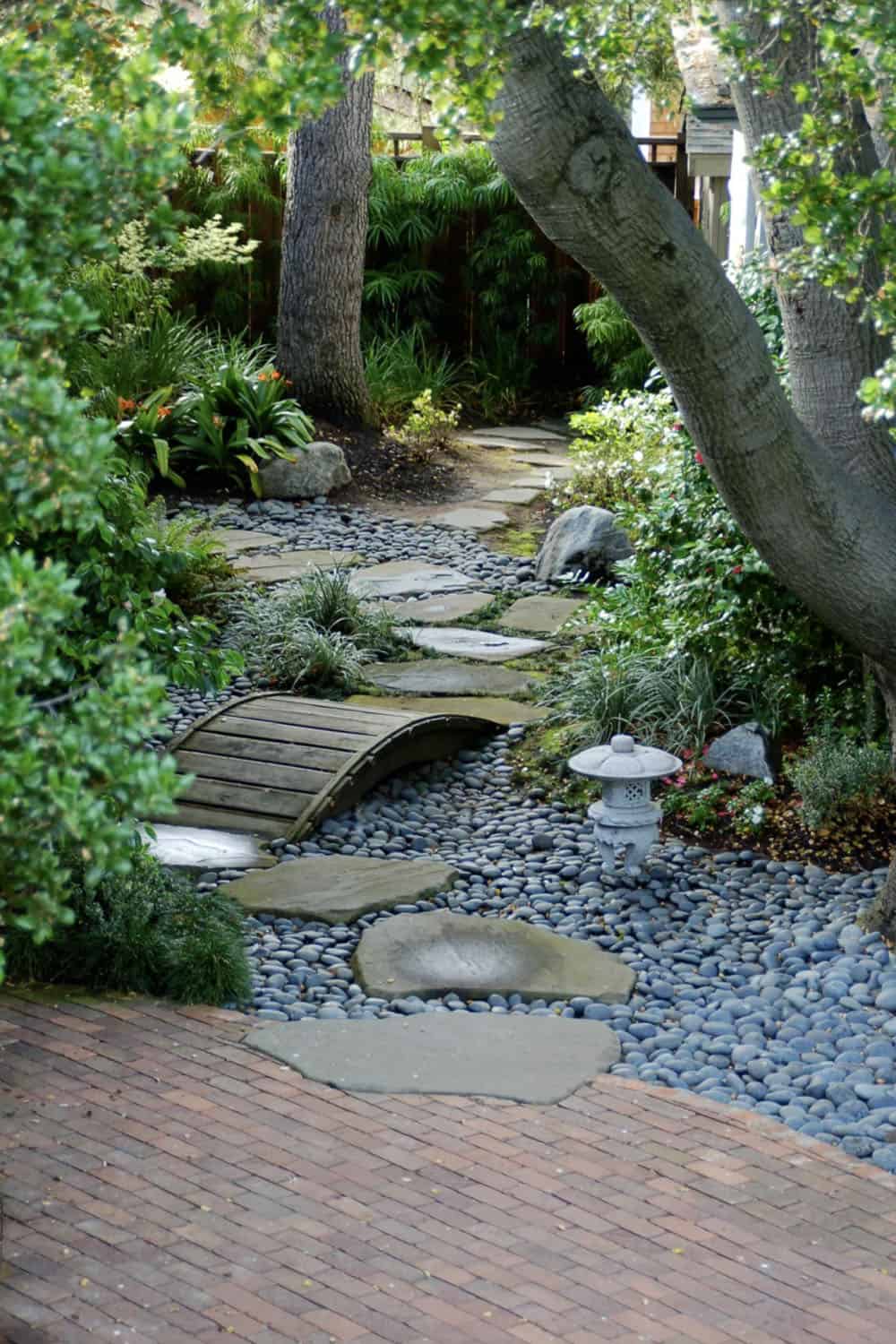
The stones are called Mexican La Paz stones, 3-4″ in diameter; they come in dark black or grey. The bridge is simple and was custom-made on site. It is made from 2×12 redwood boards with an arc cut to create the rise of the bridge. The the planks are 2×6 redwood attached with screws or nails with bamboo inserted between the redwood planks. The bamboo pieces are about 1.5-2″ in diameter. The bamboo is nail gunned in place with 16G finish nails. Redwood is allowed to grey out, no finish treatment used. Top strips are 2″ redwood ripped thin, about 3/8″ thick so they can bend easily. Attached inboard about 1.5 ” from the edge. The bridge width is about 3′ and the length is 6-7′ long. Rise is about 11″.
Arched garden bridges are made with 3/4″ pressure-treated plywood. Laminate, glue and screw the plywood after you’ve cut the plywood to the height and curve you need for the bridge truss. Lengths under 8′ are best, as longer lapping joints are necessary to create a stable bridge truss. You then use 3/8 Trt. Plywood laminated for the bridge deck. The deck is covered with a waterproof membrane roofing, which adds to the deck’s appearance. (wood, concrete, plaster, or stone, keeping in mind the higher the arch, the more you should use a rougher nonslip material). (via Richard Kramer)
8. Pathway Through Wildflowers.

Stones provide a border for a mulch pathway leading to a trellis-covered hanging swing. Covering the trellis is a Dutchman’s pipe (Aristolochia macrophylla), a hardy, deciduous, climbing vine with heart-shaped leaves. The vine prefers rich, moist, well-drained soil and full sun to partial shade. This is an excellent plant for providing shade and privacy, and its small, pipe-shaped flowers attract swallowtail butterflies. The flowers emit an odor that attracts flies, which are the pollinators. The vine is moderately resistant to deer. Beautiful wildflowers line the path of this coastal garden in Portland, Maine. (via Leandra Fremont-Smith Interiors)
9. A Winding Path.

This narrow side yard features a pathway of flagstone in a gentle curve. The winding path adds movement and feels natural in organic landscapes. (via Marilyn’s Dreamscapes)
10. Bluestone Entry Walkway.
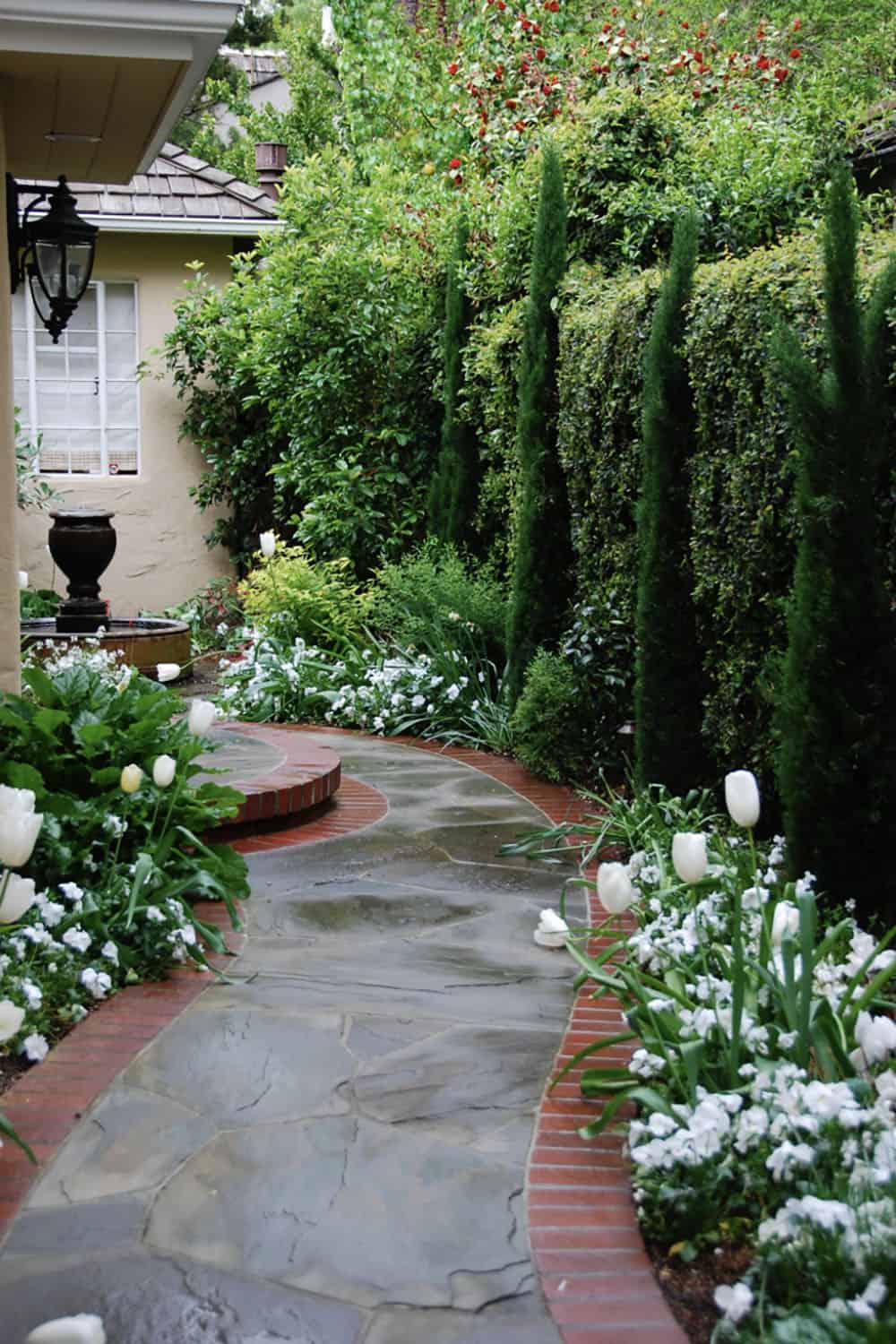
‘Tiny Tower’ Italian cypress evergreens (hardy to USDA Zone 7) provide a rhythmic structure to the flowing bluestone entry walk that terminates in a fountain courtyard. The walkway’s stone is full-range Connecticut bluestone (a sandstone with excellent slip resistance) in a random pattern with an irregular (natural) edge; the brick is McNear Common Red. Both are widely used and should be available at a stone yard near you.
A soothing palette of green and white plantings makes the space lush and cool. In the background there is a creeping Fig (Ficus pumila) on the wall, with compact Italian cypress (Cupressus sempervirens ‘Tiny Tower’) in front. Other shrubs providing structure include Osmanthus fragrans, Viburnum davidii and Spiraea japonica. The large shrub in the back corner is English Laurel (Prunus laurocerasus). The white flowers include perennials such as Francoa ramosa, as well as annual tulips (‘Hakuun’ is a nice white variety), pansy, and impatiens. FYI: The cypress trees from Monrovia Growers are very slow growers, reaching just 8-10 ft. tall, 2 ft. wide in 10 years, eventually to 25-30 ft. tall, 3 ft. wide. (via Verdance Landscape Architecture)
11. Narrow Side Yard Pathway.
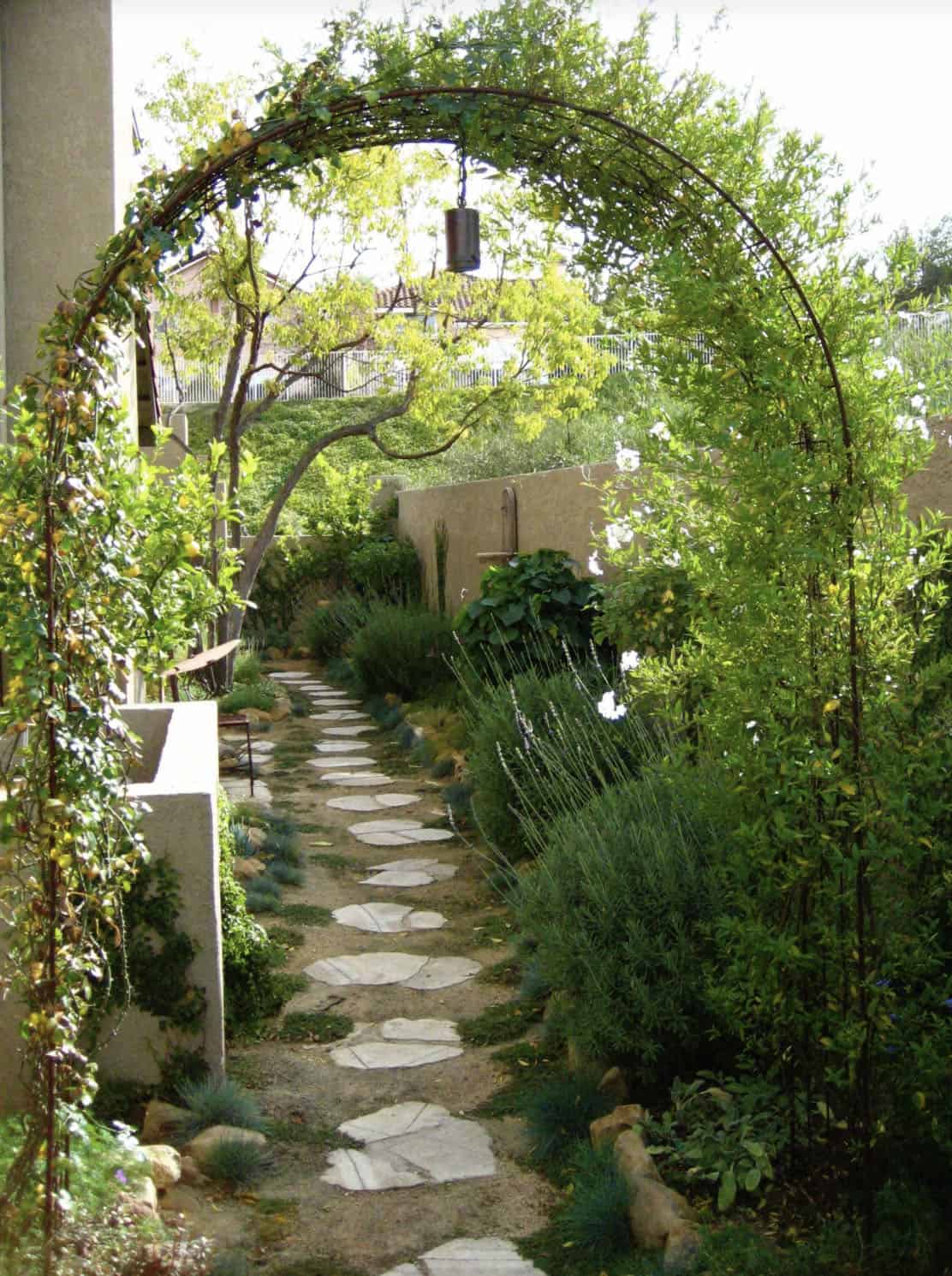
This was formerly an abandoned narrow side yard used only to store trash cans — it is 10 feet from the wall to the sliding doors, and the average is 8 feet wide. Now, it is a favorite garden stroll area for the homeowner. The pathway is made of recycled concrete pieces as “flagstone.” The arch is made from metal rebar panels that are used to reinforce concrete driveways and sourced from Sperling Nursery. If you make yourself, you will need to bend the panels and stake the bottoms into the ground. The vine on the arbor is White Potato Vine. The tree on the left is a Camphor Tree. See the complete sideyard makeover at the provided link. (via Eden Makers by Shirley Bovshow)
12. Front Entry Garden Pathway.
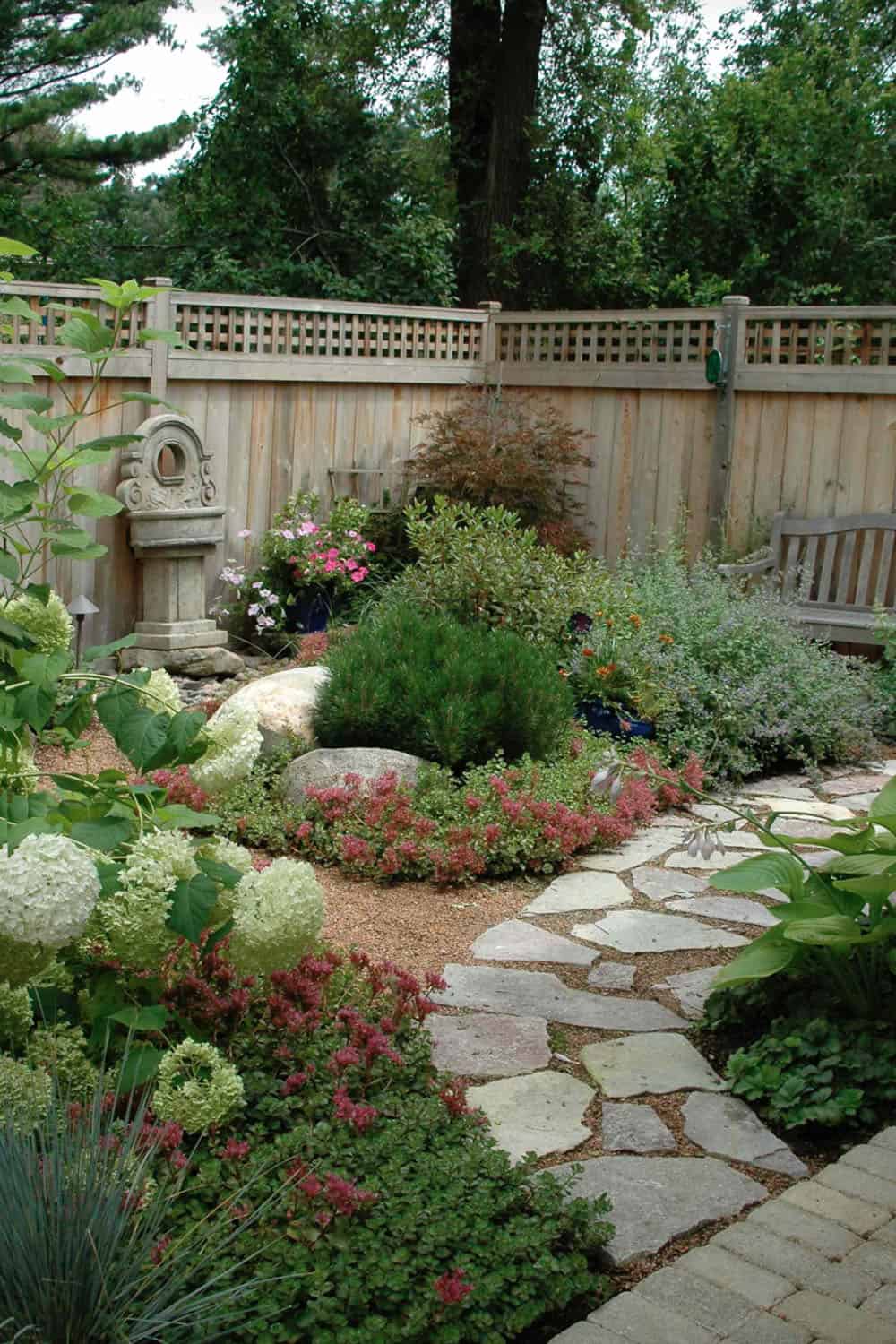
The path has a 4″ compacted gravel base, and the stone is set over screenings to level. The side path and between the flagstone is crushed granite. It comes in either terracotta or bluestone color. The plants include: evergreen shrub, Dwarf mugo pine; Ornamental tree, Japanese bloodgood maple; Groundcover, Dragons blood sedum; Deciduous shrubs, Annabelle hydrangea, Karen’s azalea; Perennials, walkers dwarf catmint, hosta; elegant, blue oat grass; Annuals, impatiens. The fence is natural western red cedar, no stain. (via Exterra Designs, Inc)
13. Pathway To A Secret Garden.
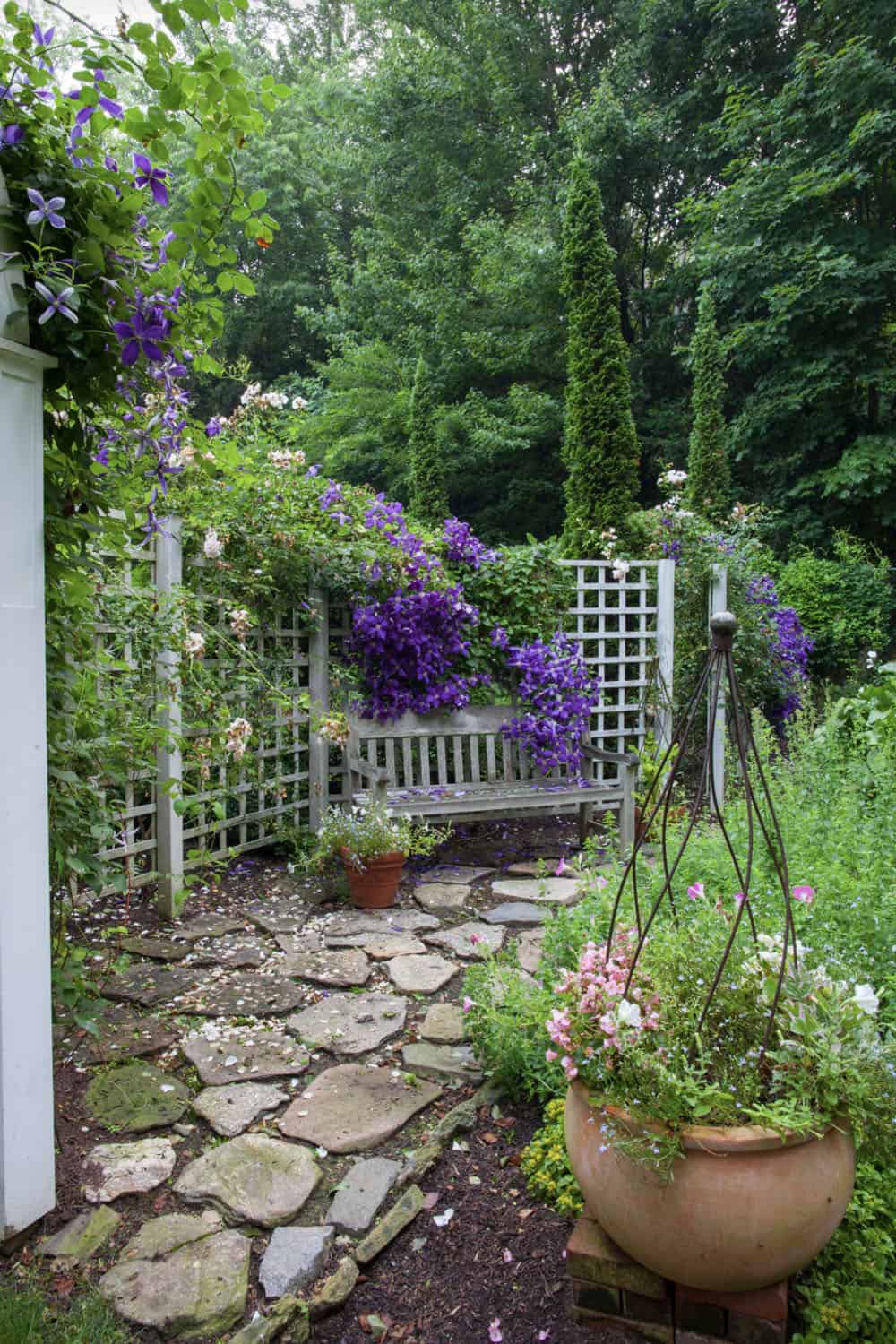
This beautiful secret garden features a stone pathway that leads to a wooden bench framed by a trellis with lush climbers, including vibrant purple clematis blooms. The path is edged with greenery and a container full of flowers. A backdrop of tall evergreens provides the feeling of seclusion. (via Oliver Design Associates)
14. Pathway Through A Shade Garden.
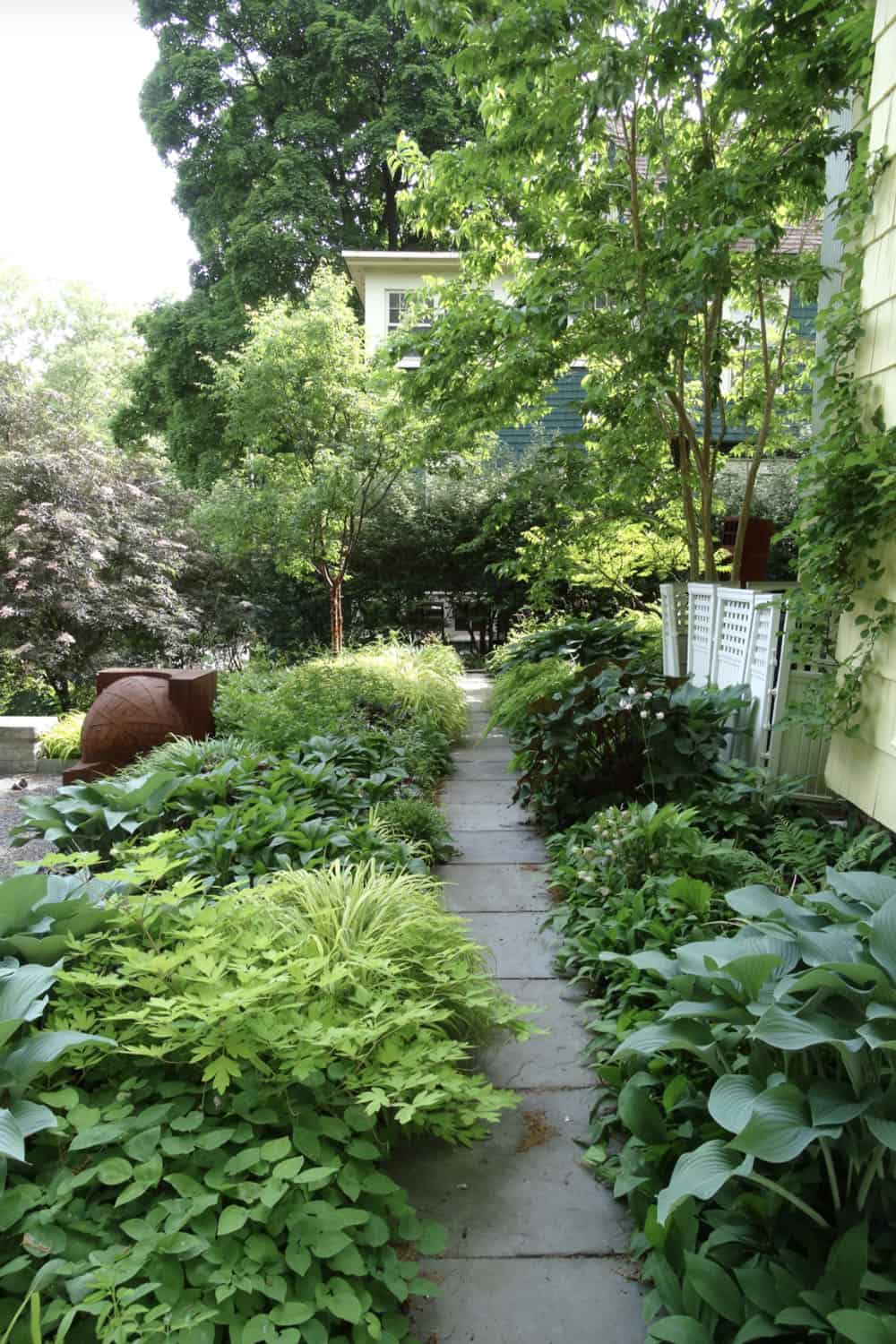
A narrow stepping stone pathway leads through this shade garden full of Hostas, Dicentra, Hakone Grass, Asarum canadense-wild Ginger, Helleborus, Epimedium, Ferns, Carex, Aquilegia & Heuchera, to name a few. This area requires very little maintenance and provides color and interest from March to November-December. (via A J Miller Landscape Architecture)
15. Stepping Stones With A Green Wall.

The stepping stones are 18″x36″ and are pre-formed concrete from Stepstone, Inc. A long green wall creates a living colorful mural on a side yard. This wall includes a combination of Epiphyte and Lithopyte plant material because the plants needed to survive without any soil for this wall project. Additional plants include Acorus, Colocasia (big foliage plants), Philodendron, Heuchera, Begonia, and Carex (the grass-like plant). There is a perforated pipe at the top of the wall that delivers water to the entire wall several times daily. (via Amelia B. Lima & Associates)
16. Pathway to a Bench.

Make a small yard feel purposeful by leading to a seating area or focal point. The arbor was custom-made in Woodstock, NY. The dark red foliage in the back of the garden is red coleus. (via Bloom Landscaping Design)
17. Flagstone Walkway In Herringbone Pattern.
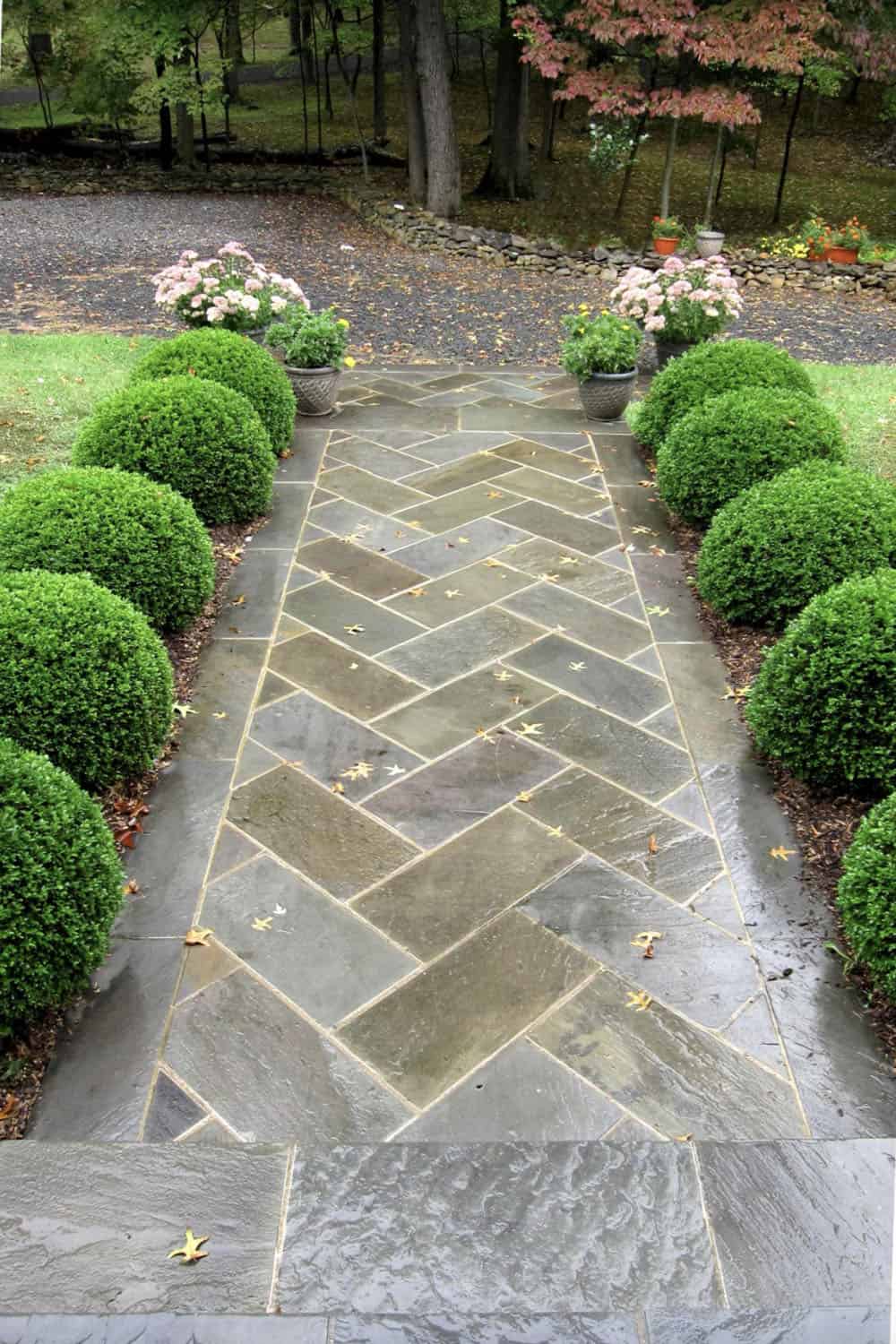
This flagstone front walkway is laid out in a herringbone pattern, adding visual interest. Neatly manicured hedges line the walkway, adding a formal aesthetic to this inviting path. (via The King’s Masons)
18. Garden Path With Water Feature.
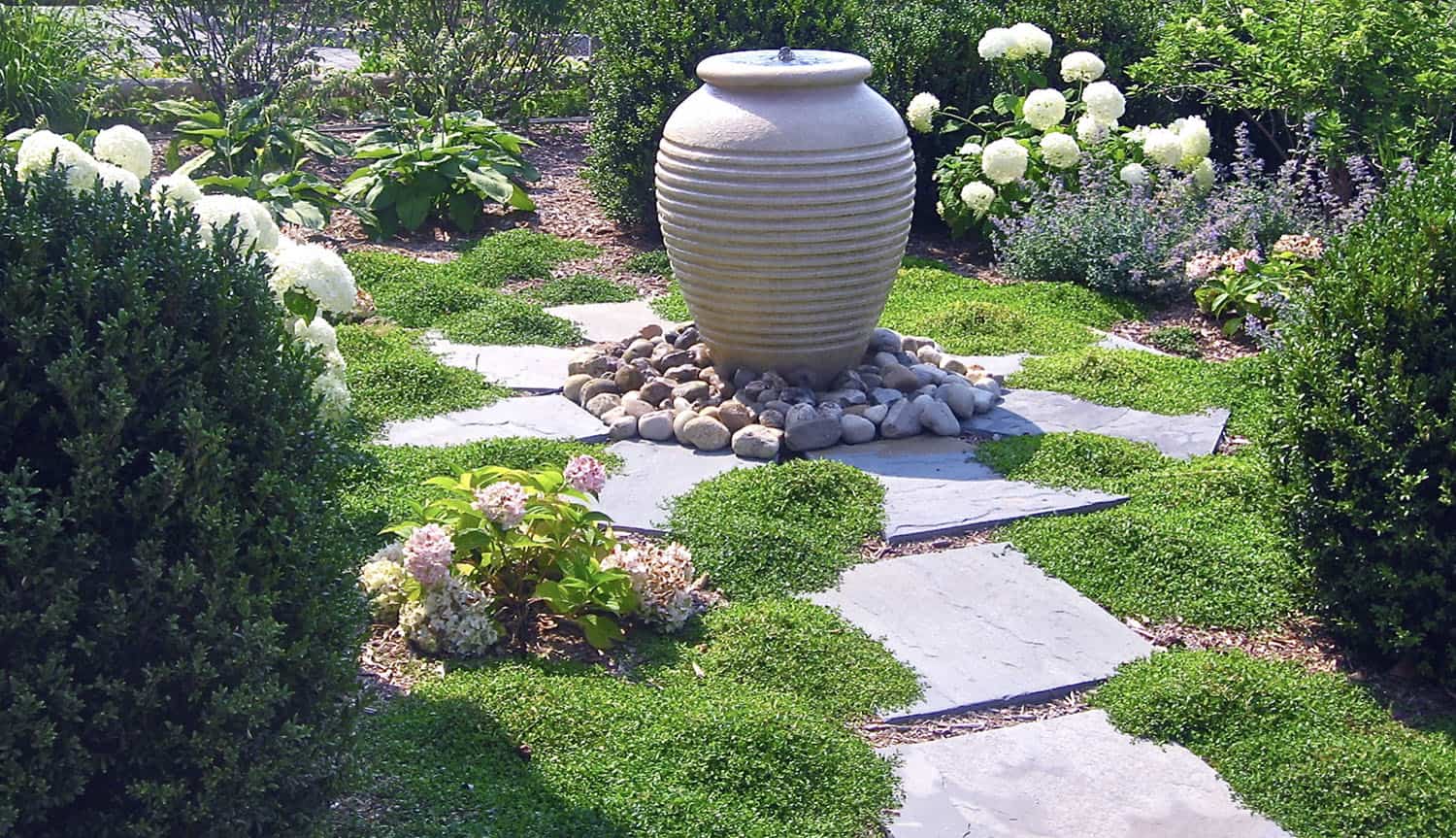
Lead your walkway to a small fountain, pond, or birdbath for a peaceful focal point. This fountain was made with an urn, so you can pick any urn and get the necessary pump and equipment to create this water feature. (via Liquidscapes)
19. Stepping Stone Sideyard.
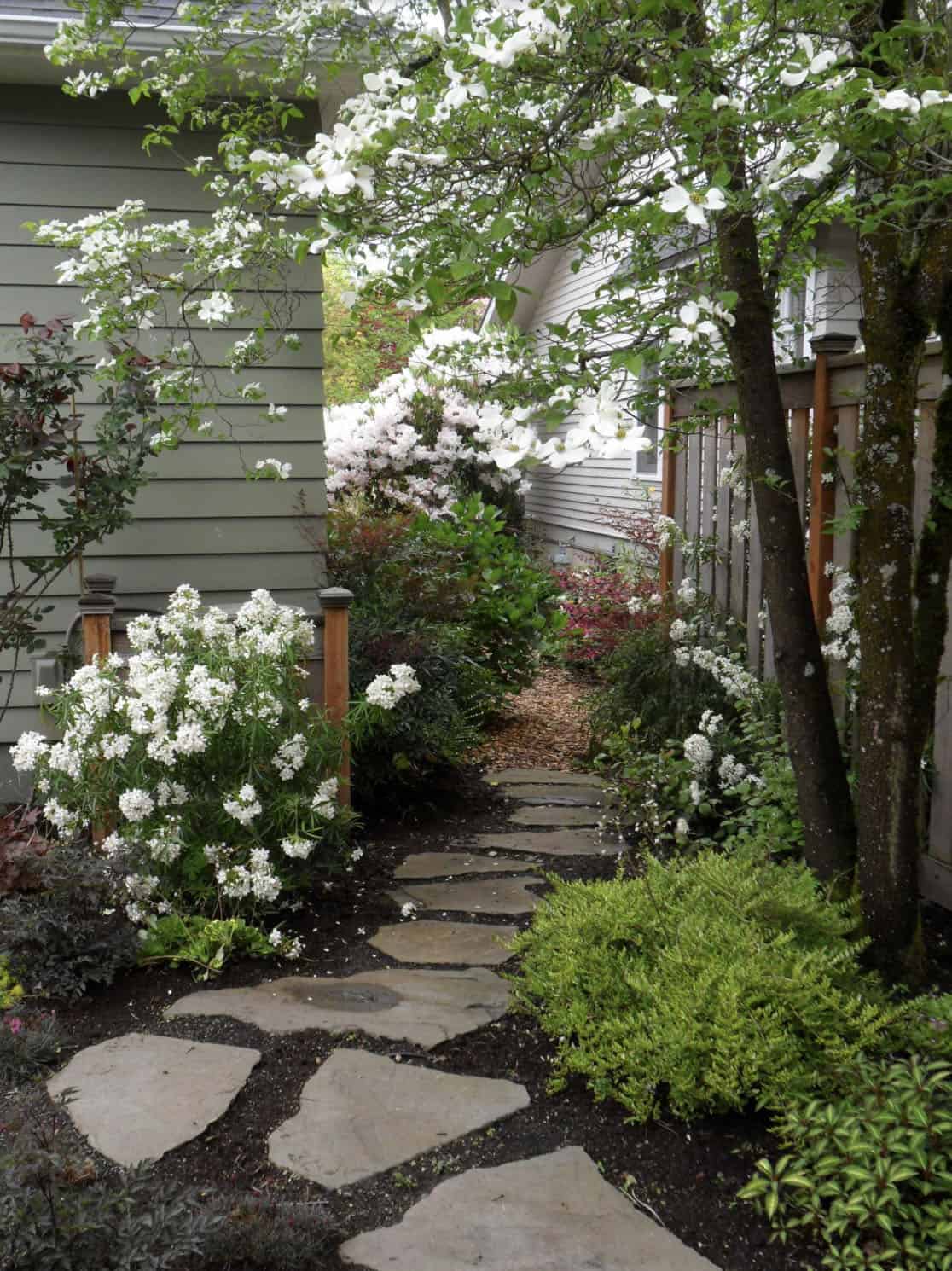
Stepping stones lead you through the side yard of this property. The tree is an Eastern Flowering Dogwood, and the white flowering shrub is Mexican Orange or Choisya ternata. In the background (center of the photo) is a fragrant Rhododendron ‘Loderi King George’ that gets big like a tree over time. The lower right-hand corner plant is a hardy impatiens, Impatiens oemiana, a deciduous perennial grown mainly for the foliage. However, it does get a yellow flower late in the summer.
The next yellowish low mounding shrub closer to the fence panel and at the base of the dogwood tree is an evergreen bush honeysuckle, Lonicera nitida ‘Lemon Beauty’, a very tough plant in the Pacific Northwest. This is variegated green and yellow. It also comes in a straight green form. It does flower (not fragrant and not very showy) and then gets some berries later in the season (also not particularly showy. (via Plan-it Earth Design)
20. Curved Path For Interest.

A historic 1912 Craftsman-style house in Vancouver, Washington, features this narrow side yard with a curved garden pathway. The flagstone is welcoming and adds visual interest to the lush garden. (via The White Pear)
21. Cottage-Style Shade Garden Pathway.

A difficult lawn space is converted into a lush shade garden on the north side of a house in Newburyport, Massachusetts. This side yard received minimal sun and was struggling to thrive. The landscape architect added plants that love the shade. A stepping stone pathway meanders through this garden and up to a fence. Plants include: Mixed hostas (Hosta spp., USDA zones 3 to 9; find your zone); Japanese painted fern (Athyrium niponicum var. pictum, zones 3 to 8); Eastern hayscented fern (Dennstaedtia punctilobula, zones 3 to 8); Ostrich fern (Matteuccia struthiopteris, zones 3 to 8); Bleeding heart (Dicentra sp.); Sweet violet (Viola odorata, zones 4 to 9); McKana’s Giant columbine (Aquilegia hybrid, zones 3 to 8); Sweet woodruff (Galium odoratum, zones 5 to 9). (via Leonard Design Associates)
22. Flagstone Stepping Path.
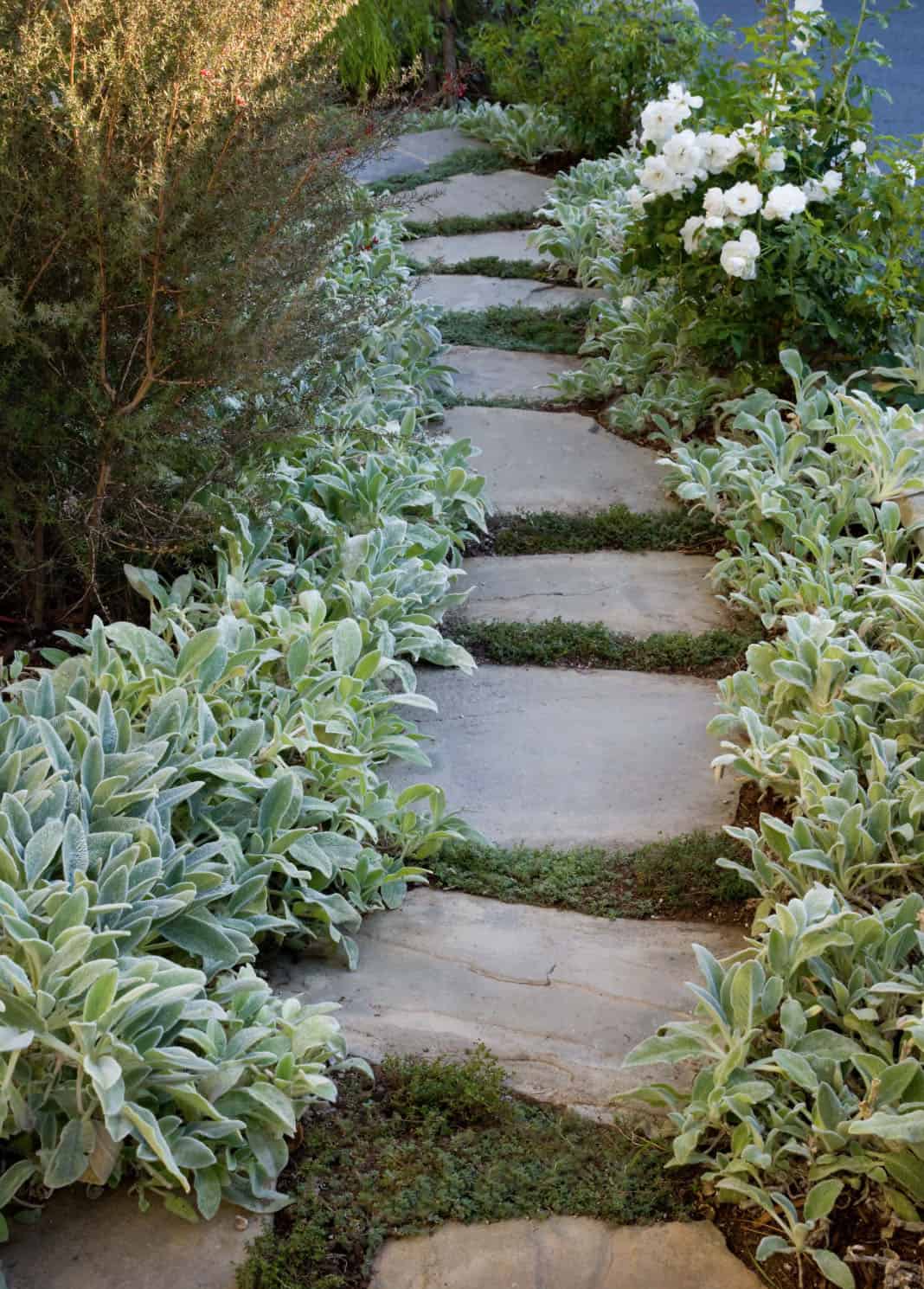
Flagstone stepping stones with ground cover between. Bordering the pathway is lamb’s ear, an easy-care perennial with soft and velvety silvery-gray leaves and pink or purple flowers. On the right side are Iceberg Roses. For the ground cover, plant moss between the rocks. For an inexpensive solution, plant thyme. (via Stout Design Build)
23. Pathway Through A Drought-Resistant Garden.

For the pathway, irregularly cut bluestone was used to create this timeless look. The stones are mortared in place. For this garden, there are over 75 different varieties of plants, all specifically chosen, as they are drought-resistant. This includes: Phlox paniculata: David, Blue Paradise, Bright Eyes, Lilium ‘After Eight’ and ‘Casa Blanca’, Platycodon grandiflorus, Echincea ‘Magnus’ and ‘Kim’s Knee High’, Anemone ‘Honorine Jobert’, ‘September Charm’, Rosa cl Pink Eden, Rosa cl New Dawn, Leuchanthemum ‘Becky’, Nepeta ‘Walker’s Low’, Senorita Rosalita Cleome, Eupatorium, Alcea, Allium ‘Globemaster’, Ilex ‘Skypencil’, Buxus sempirvirens suff., Mandevilla, Rosa ‘Princess Diana’, Rosa ‘Enchanted Evening’, Rosa ‘Gertrude Jekyll’, Rosa ‘Pink Promise’, Rosa ‘Bonica’, Rosa ‘Pretty Woman’, Rosa ‘Appleblossom’, Peonia ‘Sarah Bernhardt’, ‘Festiva Maximus’. The Supertunias are ‘Vista Silverberry’, ‘Vista Bubblegum’ with a verbena mixed in. (via Maria Hickey & Associates Landscapes)
24. Rustic Stepping Stones.

Rustic step-stones in moss pass between lush perennial plantings. The moss is Sagina subulata. It will tolerate sun, but only if the soil is kept consistently moist. It will not do well in hot, dry conditions. The shade-loving plants edging the pathway include: Athyrium niponicum var. pictum; Anemone japonica ‘Honorine Jobert’; Dicentra cucullaria; Thalictrum aquilegifolium; Polystichum munitum, and various Hosta species. (via Samuel H. Williamson Associates)
25. Gravel Walkway With Edging.
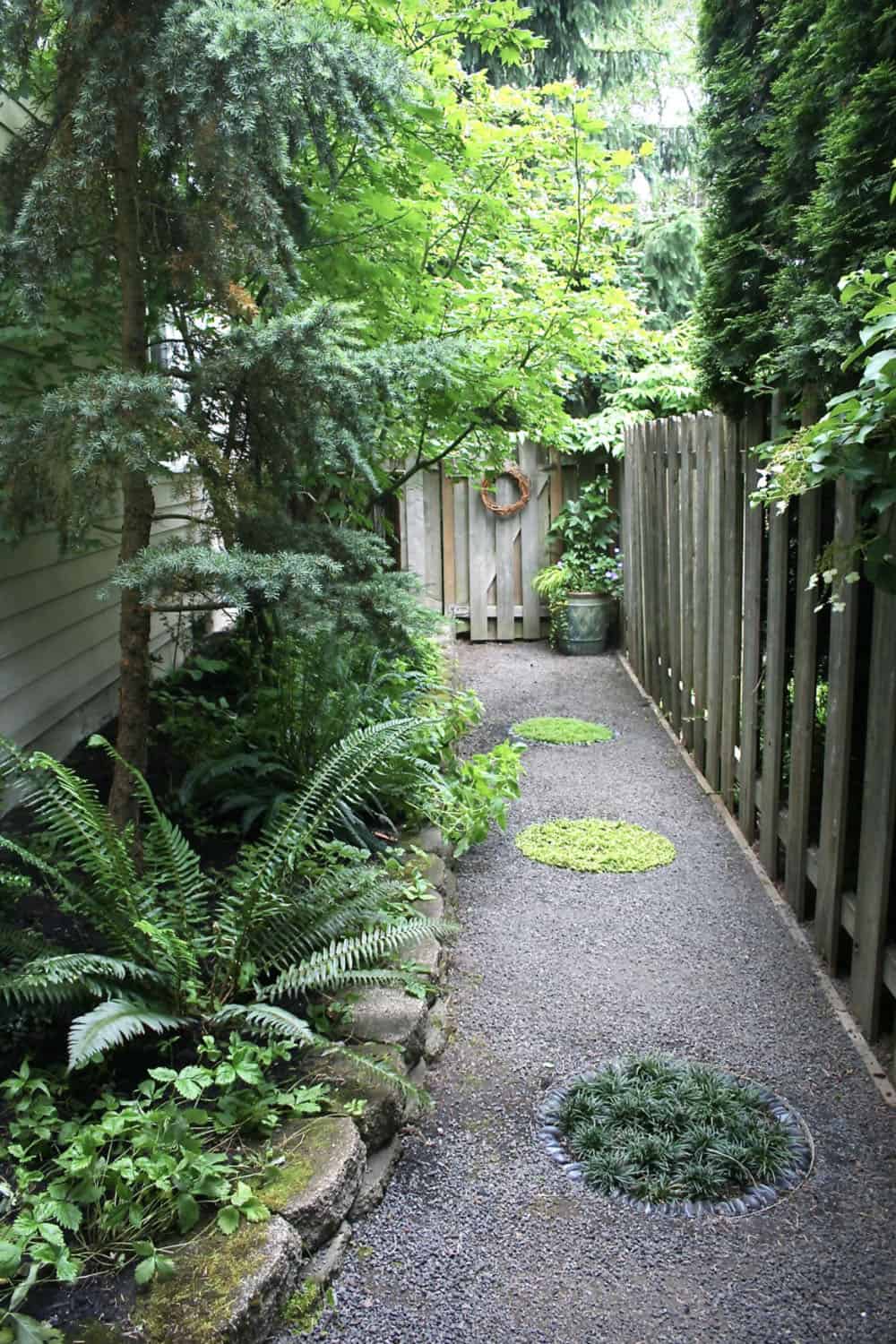
This narrow side yard features a gravel path with inlaid “stepping stones” made of metal hoops used on whiskey or wine barrels. The half barrels were originally used as planters, but eventually the wood decays, leaving behind only the metal hoops. They were repurposed as edgers for “stepping stone” circles embedded in the gravel and ringed with Mexican black pebbles. Inside the stepping stones are plantings of Corsican mint, Veronica repens ‘Sunshine’, and Dwarf mondo grass (each circle only has one type of plant in it).
Plantings along the pathway include natives such as evergreen huckleberry, mountain hemlock, sword fern, and deer ferns. The tree in the foreground is a mountain hemlock, which grows very narrow. In the background, you can see the branches of a vine maple. Both trees are native to the Pacific Northwest. The path is made of one-quarter minus crushed basalt. It packs down firmly and creates a hard but permeable surface.(via Visionscapes NW Landscape Design)
26. Gravel Pathway With Edging.
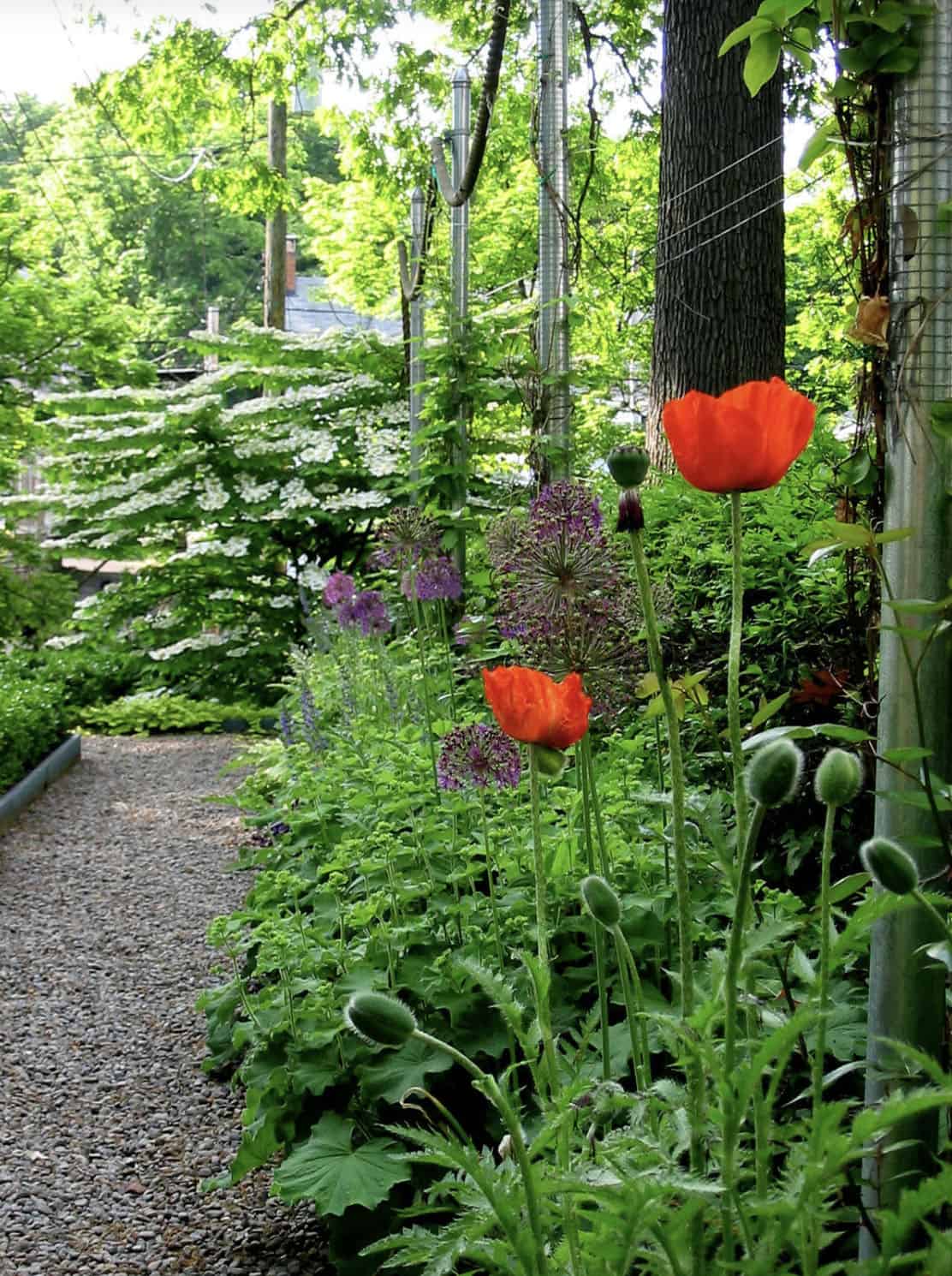
Gravel pathway with a Rose garland running along one side. A selection of simple to grow perennials along the path includes Oriental Poppies (red flowers), Salvia, Ladies Mantle, Acanthus, and Ornamental Onions – Allium aflatunense ‘Purple sensation’. The large shrub at the end of the path is a Viburnum plicatum f. tomentosum ‘Mariesii’ – Double File Viburnum, it prefers semi shade, this one is fully grown at 12 ft high by 15 ft wide, it is best planted where it can grow to full size and not get trimmed or pruned that way the structure and flowers and branches grow horizontally. (via A J Miller Landscape Architecture)
27. Pathway Through Ground Cover.

A flagstone path leads one through this delightful garden. The ground cover is Scotch Moss (Sagina subulata ‘Aurea’) and is suitable for use in zones 3-9. It may freeze at 4-5 zone, but then recover. Just do not use it as a lawn, as it’s difficult to care for. Use Scotch Moss for a small area, such as rockeries or a Japanese garden. The light blue flowers are pansies. The purple flower is Salvia nemerosa ‘East Friesland’ (Meadow sage). (via Kristen Rudger Landscape Design)
28. Pathway To A Fence.
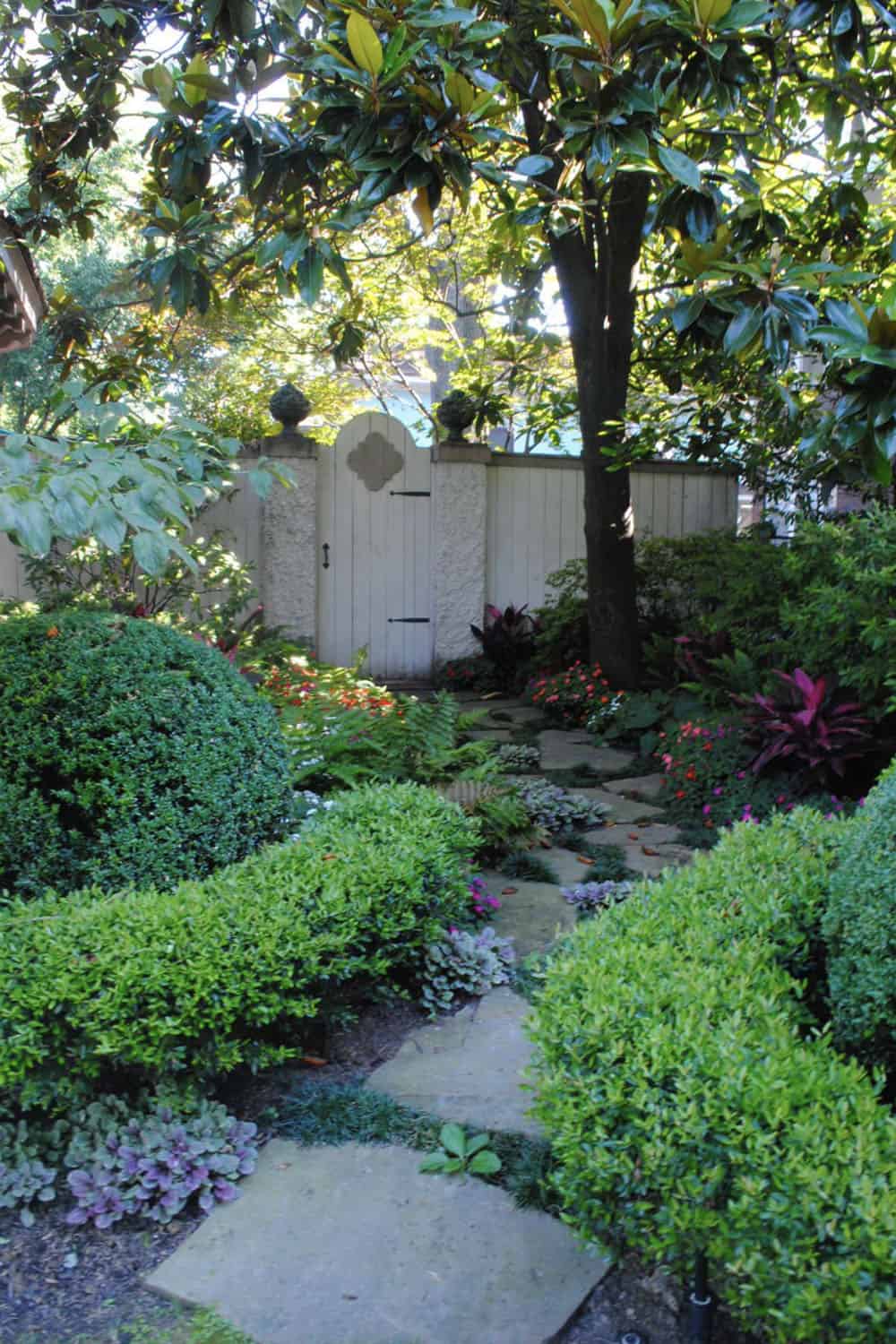
A beautiful 7-foot-tall cedar fence complements a wonderful pathway through the gardens. The cap on top of the fence is made from concrete. The gate design is an “Arts and Crafts” design that goes with the period of the house. The posts are brick and painted to match the fence. The hedge that lines the pathway is helleri holly. It gets trimmed three times a year to keep it compact and shaped. Bugs are no issue and they are disease-resistant.
The multi-colored plant in front of the gate is a Mixed Impatien. The purple plant next to the stone is Burgundy Glow Ajuga. They do not tolerate full sun; they need full shade. The reddish/purple plant in the back is Red Sister Ti Plant. Also, full shade. The hot pink/green spike-leaved plant is called a Ti Red Sister. It is an annual, shade plant. (via Gurley’s Azalea Garden)
TIPS TO PROTECT YOUR GARDEN FROM DEER
Here is a great tip if you are worried about deer eating your plants. Deer are a tough problem to have, as they’ll eat just about anything if they are hungry enough. That being said, Hosta is one of their favorite foods. Try placing catmint plants amongst the hostas, and the deer will avoid the area. A couple of suggestions of perennials that will tolerate shade and not get eaten by deer are: Ferns, Dicentra, Helleborus, Ligularia, Hakonechloa, and Pulmonaria.
TIPS TO PROTECT YOUR GARDEN FROM GOPHERS
The best way to keep gophers away is a fence with a portion of the wire mesh buried underground to prevent them from digging under. They don’t like anything spicy, so hot pepper spray applied to the plants you’re trying to protect can work, but it must be applied frequently, as it washes off.

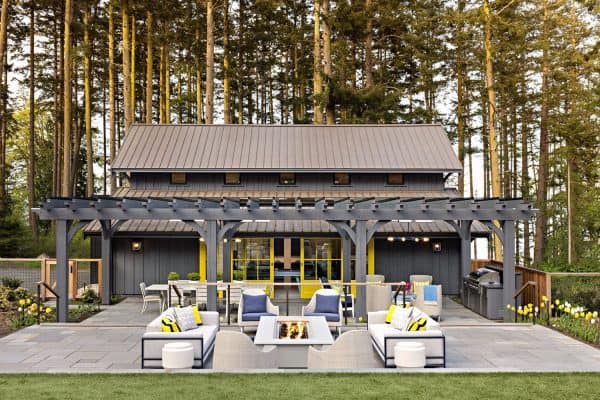





1 comment